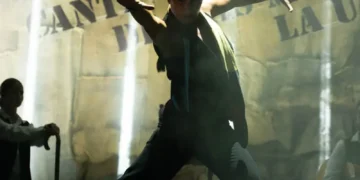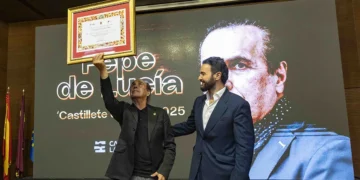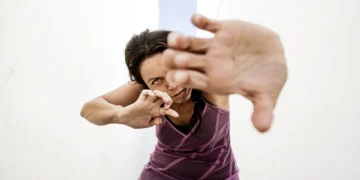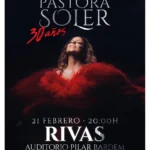Friday, September 14th, 2012
Text: Estela Zatania
Photos: La Bienal
Viva the Constitution, and viva Málaga!
The weekend programming at the Bienal de Flamenco de Sevilla offered a mixed bag of items to suit all tastes.
On Thursday night, within the parallel activities, the world premiere of “El Fabuloso Sabicas”, a documentary by Pablo Calatayud that explores the life and work of the genius from Pamplona whose centennial is being celebrated this year, was shown downtown at installations of Seville university. On Friday afternoon, within the series “Cien Años de Cante”, (a hundred years of flamenco singing), the title couldn’t have been more suitable in light of the two singers from Sanlúcar who appeared: young hopeful María Mezcle, and the admired maestra Encarnación Marín “La Sallago”, 93 years old and counting, who delighted the audience with a couple of fragments of song and dance. Both were accompanied by Adrián Lozano on guitar.
“Málaga”
Cancanilla de Marbella, La Cañeta, El Carrete, Chato de Vélez, La Lupi
Hotel Triana, 11:30pm
At the 2010 Bienal it was the people of Extremadura who demonstrated that yes, there is flamenco outside the small irregular geographical triangle of Seville-Jerez-Cádiz, and quite good at that. This time it was the turn of Málaga, another “exotic land”. Ever since the tourist boom of the sixties triggered the disintegration of the province’s flamenco ambience, Málaga has lost some relevance, while at the same time its interpreters have continued to cultivate their personal take on the genre
It was a tremendous night at the Hotel Triana with these people. Five very different performers brimming with personality gave absolutely fresh performances, once again proving that traditional flamenco has endless possibilities when handled by people who know the ropes. Chato de Vélez, a little-known singer with much experience singing for dance as well as solo, with Antonio Soto on guitar, sang soleá, siguiriyas and bulerías with knowledge, compás and a good voice, getting the audience warmed up for La Lupi. Despite her many years of experience, this dancer is being discovered now thanks to her collaboration with Miguel Poveda in the presentation tour of his new recording. Backed up by the singing of Antonio Campos and el Pulga, and the guitar of Curro de María, she highlighted the abandolao compás of her hometown with an interpretation that was original and very flamenco, and gave new life to liviana and serrana with the María Borrico ending, all interpreted in an irresistibly dynamic style.
Cancanilla de Marbella or de Málaga, depending on what mood he’s in, one of the great classic singers, with his sidekick guitarist Antonio Moya who accompanies so intelligently and respectfully, and with his customary Mairena-style delivery, sang soleá, tientos tangos and siguiriyas.
Two thoroughly original artists took Triana by surprise last night. Two inspired flamenco veterans with a great deal to offer. Carrete, a more idiosyncratic dancer does not exist. La Cañeta, creative and powerful. The former, with his Fred Astaire aesthetic, his fine sense of the surreal nature of life and his ability to express it via flamenco. And then, Cañeta, the most profound festive artist, pure inspiration, reinventing herself at each moment. Without even realizing it, both echoed Triana forms from times past and the communication with the audience was perfect. Who says Málaga flamenco is just malagueñas and Piyayo?
Sara Baras “La Pepa”
Teatro de la Maestranza, 8:30pm
Dance: Sara Baras, José Serrano, Carmen Camacho, Charo Pedraja, Cristina Aldon, Isabel Ramírez, Macarena Ramírez, María Jesús García, Natalia López, Tamara Macías, Alejandro Rodríguez, Daniel Saltares, David Martín, Manuel Ramírez, Raúl Fernández. Guitar: Keko Baldomero, Miguel Iglesias. Cante: Emilio Florido, Saúl Quirós, Miguel Rosendo. Percussion: Antonio Suárez “Pájaro”. Special guests: Ara Malikian, Aupaquartet string quartet. Script, director and choreography: Sara Baras. Music: Keko Baldomero
Nowadays flamenco is at the service of all sorts of narratives and story-lines. From Lorca and Greek tragedies, to dancing about architecture, the genre has enough flexibility to adapt to any script, although the results can be uneven. So it should come as no surprise that popular dancer Sara Baras was commissioned to create a work related to the bicentennial of the Spanish Constitution of 1812, known affectionately as the “Pepa” since it was signed on the saint’s day of that name. “La Pepa” is the title of the show we saw last night at the Teatro de la Maestranza and which is scheduled for three consecutive days.
Dance the Constitution…easier said than done, it almost sounds like a joke. Sara Baras resolved the challenge with a “literal” interpretation that included cannons, soldiers, Puerta Tierra, sounds of war, etc. But it would take a very large shoehorn to insert flamenco into a historic setting which, at best, would only have the very earliest sort of pre-flamenco. We’ve assimilated “Medea” and Dante’s Inferno adapted to flamenco…it’s hard to say why this is harder to swallow. Possibly because it refers to such specific events that occurred relatively recently.
The show itself is less splashy than others the Cádiz dancer has offered, denser, darker. It depends heavily on footwork and percussion, and makes too little use of the three fine singers, Miguel Rosendo, Emilio Florido and Saúl Quirós. Too much time is spent on group numbers – after a couple of minutes of eight or ten people dancing in unison, the effect loses novelty and starts looking retro.
Flamenco dance has evolved rapidly in a very short time. “La Pepa” has the look of the 1990s…the last century. It will probably do very well abroad, which is important given the intent of this institutionally commissioned work.
Descubre más desde Revista DeFlamenco.com
Suscríbete y recibe las últimas entradas en tu correo electrónico.






























